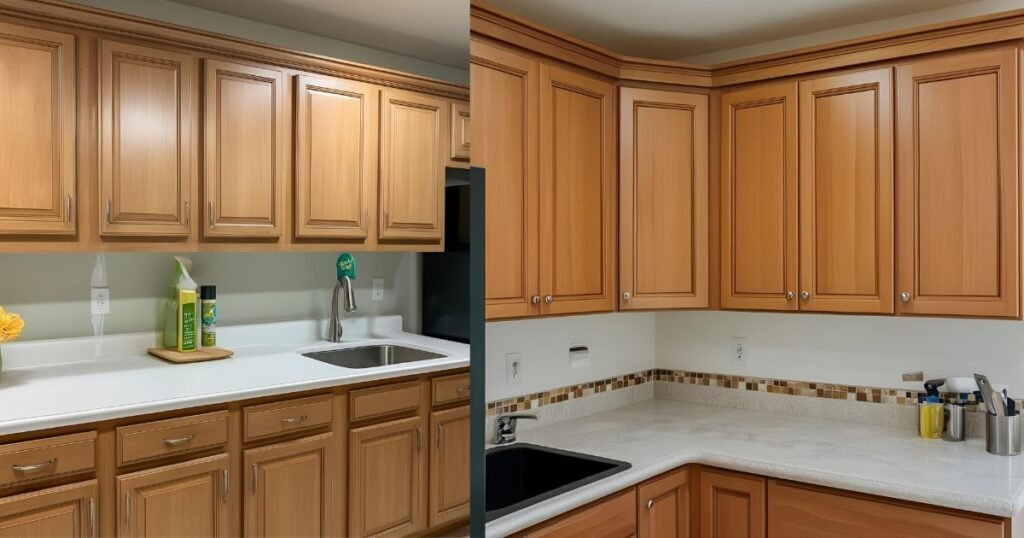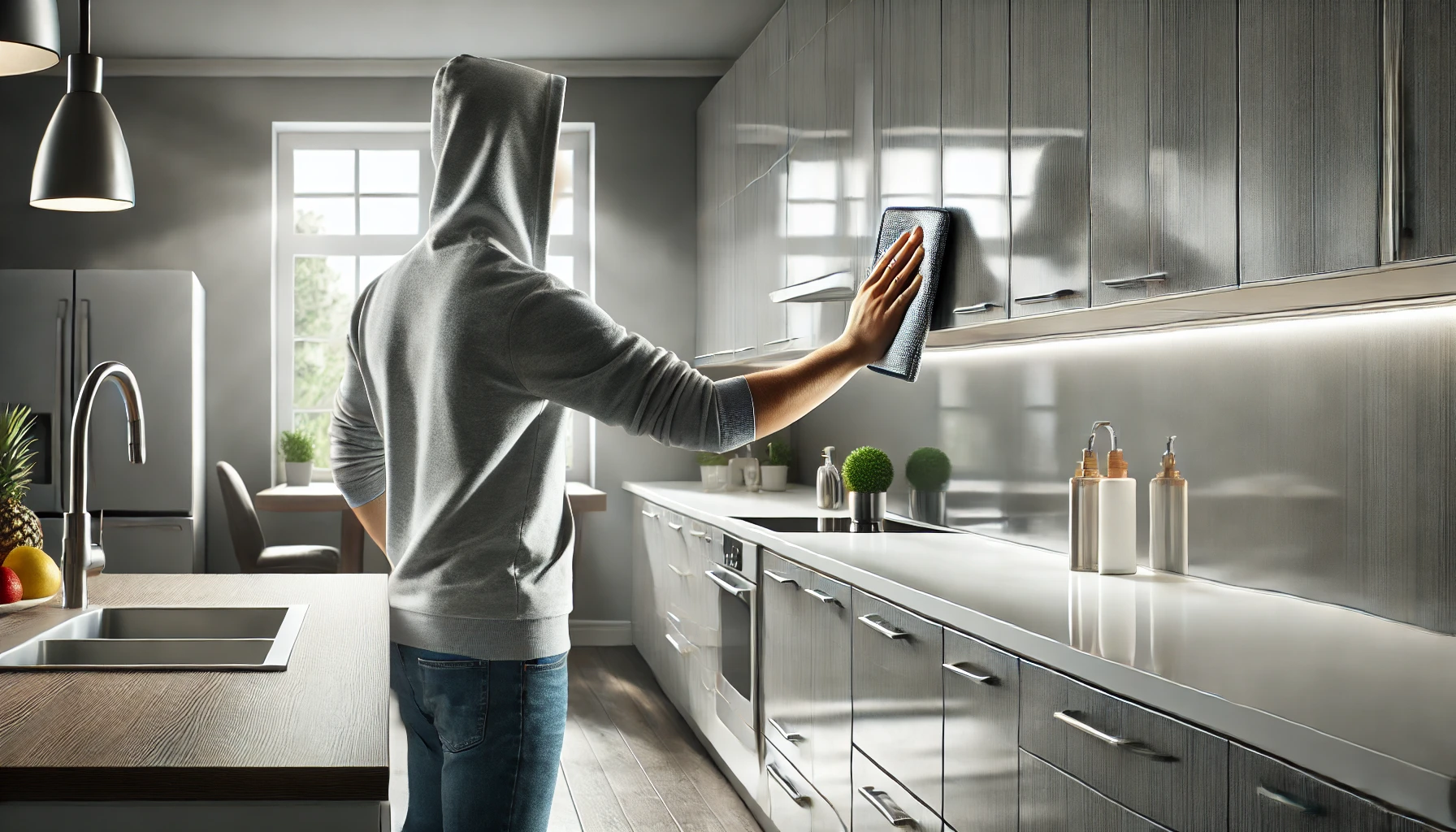Laminate kitchen cabinets are popular due to their durability, affordability, and sleek appearance. However, they require proper care to avoid streaks, grease buildup, and dullness over time. Unlike solid wood, laminate surfaces are made from compressed fiberboard with a plastic-like coating, making them more resistant to stains but also prone to streaking when cleaned incorrectly.
This guide will provide a step-by-step approach to cleaning laminate cabinets without streaks. By using the right cleaning techniques, tools, and solutions, you can maintain the beauty and longevity of your kitchen cabinets. Whether you are tackling everyday smudges, greasy stains, or deep cleaning, following these steps will ensure a streak-free shine.
Introduction
Importance of Keeping Laminate Cabinets Clean
Kitchen cabinets are exposed to daily wear and tear from cooking, spills, and airborne grease. Over time, grease and grime accumulate, making the cabinets look dull and unappealing. Regular cleaning prevents long-term stains and discoloration, keeping your kitchen looking fresh.
Well-maintained laminate cabinets not only enhance the kitchen’s appearance but also prolong their lifespan. Proper cleaning prevents warping, peeling, and damage caused by harsh chemicals or excess moisture.
Common Issues: Streaks, Grease, and Buildup
One of the biggest challenges in cleaning laminate cabinets is preventing streaks. Many homeowners notice streaking after wiping down cabinets, which occurs due to excessive moisture, soap residue, or improper drying techniques.
Grease buildup is another common issue, especially in kitchens where frying and sautéing are frequent. Over time, the grease hardens and becomes difficult to remove without the right cleaning approach.
Why Laminate Cabinets Require Special Care
Unlike wood, laminate is non-porous and does not absorb moisture. This makes it resistant to mold and mildew but also means that too much water or strong chemicals can damage the surface. Abrasive cleaners can scratch or dull the laminate finish, reducing its shine over time.
To maintain laminate cabinets, it’s essential to use gentle cleaning solutions, avoid excessive water, and dry the surfaces properly after cleaning.
Step 1: Gather Your Cleaning Supplies
Before starting the cleaning process, it’s crucial to have the right supplies. Using the proper tools and solutions will make the job easier and prevent damage to the laminate surface.
Essential Cleaning Tools
To clean laminate kitchen cabinets effectively, you need the following tools:
- Soft microfiber cloths – These are gentle on the laminate surface and help prevent scratches and streaks.
- Non-abrasive sponge – Ideal for tackling stubborn stains without damaging the finish.
- Spray bottle – Useful for evenly applying cleaning solutions.
- Bowl for mixing solutions – Helps prepare homemade cleaning solutions for a safe and effective clean.
Recommended Cleaning Solutions
Choosing the right cleaning solution is key to avoiding streaks. Here are three effective options:
- Mild dish soap and warm water – This is the safest and most effective everyday cleaner. A few drops of dish soap in warm water can cut through grease and grime without leaving streaks.
- Vinegar and water solution (1:1 ratio) – White vinegar is a natural degreaser and disinfectant. Mixing it with water creates a streak-free cleaning solution.
- Commercial laminate cabinet cleaner – Many store-bought cleaners are formulated to clean without leaving streaks. Look for one labeled “streak-free” to achieve the best results.
Step 2: Pre-Cleaning – Removing Dust and Loose Debris

Before applying any cleaning solution, it’s essential to remove loose dirt, dust, and food particles from your laminate cabinets. This ensures a more effective clean and prevents streaking caused by dirt smearing across the surface.
Dry Dusting
Dust and crumbs often settle on cabinet surfaces, especially around handles and edges. A microfiber cloth is the best tool for dry dusting, as it effectively picks up dust without spreading it.
To dust your cabinets:
- Use a dry microfiber cloth to wipe down cabinet doors, edges, and handles.
- Pay attention to crevices where dust and grime accumulate.
- If needed, use a soft-bristled brush to reach tight corners.
Dry dusting is an important step because adding moisture to dusty surfaces can create mud-like smudges, which are harder to clean.
Spot Cleaning Sticky Residue
For sticky spots or minor spills, a damp microfiber cloth with a few drops of dish soap is the best approach.
Steps for spot cleaning:
- Dampen a microfiber cloth with warm, soapy water.
- Gently rub the sticky area in a circular motion.
- Wipe with a clean, damp cloth to remove soap residue.
- Dry immediately to prevent streaks or moisture damage.
Avoid soaking the laminate surface with too much water, as excess moisture can seep into the edges and cause warping.
Read More: how to clean laminate kitchen cabinets
Step 3: Deep Cleaning Without Streaks
Once the dust and loose debris are removed, it’s time to deep clean the cabinets. This step ensures a thorough removal of grease, fingerprints, and any built-up grime.
Applying the Cleaning Solution
To avoid streaks, lightly spray the cleaning solution onto the cabinet rather than drenching it. Oversaturation can leave watermarks and damage the laminate.
- Choose your preferred cleaning solution (dish soap, vinegar solution, or commercial cleaner).
- Lightly spray the cabinet surface or dampen a microfiber cloth and wipe.
- Allow the solution to sit for 1-2 minutes on stubborn grease spots before wiping.
Wiping the Surface Properly
Wiping technique plays a crucial role in streak prevention. The best method is to:
- Use a microfiber cloth in gentle, circular motions.
- Avoid scrubbing too hard, as excessive pressure can dull the laminate finish.
- Work in small sections to ensure even cleaning.
Rinsing Off Residue
Leftover soap or vinegar residue can cause streaks if not properly rinsed. Use a damp cloth with clean water to remove any remaining solution.
Steps:
- Wipe the cabinets with a clean, damp cloth soaked in plain water.
- Dry immediately with a fresh microfiber cloth to avoid water streaks.
This ensures the surface is clean and streak-free after deep cleaning.
Step 4: Drying and Buffing for a Streak-Free Shine
Even after cleaning, improper drying can lead to streaks or water spots. This step ensures that your cabinets look flawless and free from any residue.
The Importance of Drying
Water left on laminate cabinets can cause visible streaks or even seep into the edges, leading to potential damage. Proper drying is essential for:
- Preventing water stains and streaks.
- Maintaining the laminate’s shine and smooth finish.
- Avoiding long-term moisture damage.
After wiping the cabinets with a damp cloth, immediately dry them using a soft microfiber cloth. This ensures no moisture remains on the surface.
Buffing for a Streak-Free Finish
Buffing is the secret to achieving a polished, streak-free look. Here’s how to do it:
- Take a dry microfiber cloth and gently buff the cabinet surface.
- Use circular motions to ensure an even shine.
- Pay extra attention to high-touch areas, such as around handles, where streaks are most visible.
This step enhances the appearance of your cabinets, making them look as good as new!
Read More: how to clean white kitchen cabinets
Step 5: Maintaining Your Laminate Kitchen Cabinets
Keeping your cabinets clean requires a simple routine maintenance plan. By incorporating small cleaning habits, you can prevent dirt buildup and keep your cabinets looking great year-round.
Regular Cleaning Routine
To prevent deep-set stains and grime, follow this routine:
- Weekly: Wipe down cabinets with a dry microfiber cloth or a damp cloth with mild soap.
- Monthly: Perform deep cleaning using vinegar-water solution or a streak-free cleaner.
- As needed: Address grease buildup near the stove immediately to prevent permanent stains.
A consistent cleaning schedule will make maintenance easier and extend the lifespan of your laminate cabinets.
Preventing Future Streaks and Buildup
Some practical tips to avoid streaks and grease buildup:
- Immediately wipe spills and grease splatters to prevent them from hardening.
- Avoid over-spraying cleaning solutions—excess liquid causes streaks.
- Always dry the surface thoroughly to prevent water spots.
By adopting these habits, you can keep your cabinets in pristine condition with minimal effort.
Best Products to Use for Long-Term Care
Not all cleaning products are safe for laminate cabinets. Here are the best options:
- Streak-free cabinet sprays – These are specially formulated to clean without leaving streaks.
- Furniture polish (laminate-safe) – Provides a glossy, protective finish while repelling dust.
- DIY solutions (vinegar + water) – An affordable, effective alternative for regular cleaning.
Avoid harsh cleaners like bleach, ammonia, or abrasive powders, as they can damage the laminate’s surface.
Common Mistakes to Avoid
Many people unknowingly use cleaning methods that harm laminate cabinets. Here are some mistakes to steer clear of:
Using Abrasive Sponges or Scouring Pads
Rough sponges can create tiny scratches on the laminate surface, making it look dull over time. Always opt for soft microfiber cloths or non-abrasive sponges to preserve the smooth finish.
Applying Too Much Water
Excess moisture can seep into the edges and joints, causing swelling or warping. Always use a damp (not soaking wet) cloth and dry the surface immediately after cleaning.
Using Harsh Chemical Cleaners
Products like bleach, ammonia-based cleaners, or harsh degreasers can dull the laminate finish and cause discoloration over time. Stick to gentle, streak-free formulas to maintain the cabinet’s original look.
Conclusion About How to Clean Laminate Kitchen Cabinets Without Streaks
By following the right cleaning techniques, you can keep your laminate kitchen cabinets looking spotless and streak-free. Here’s a quick recap:
- Gather the right supplies: Use microfiber cloths and mild cleaners.
- Pre-clean properly: Remove dust and loose debris before deep cleaning.
- Use the correct wiping technique: Avoid oversaturation and always rinse off residue.
- Dry and buff for a streak-free finish: This final step ensures no water spots are left behind.
- Maintain regularly: A simple weekly wipe-down prevents buildup and extends the cabinet’s life.
By following these step-by-step guidelines, you’ll enjoy shiny, streak-free laminate cabinets that enhance the beauty of your kitchen!

